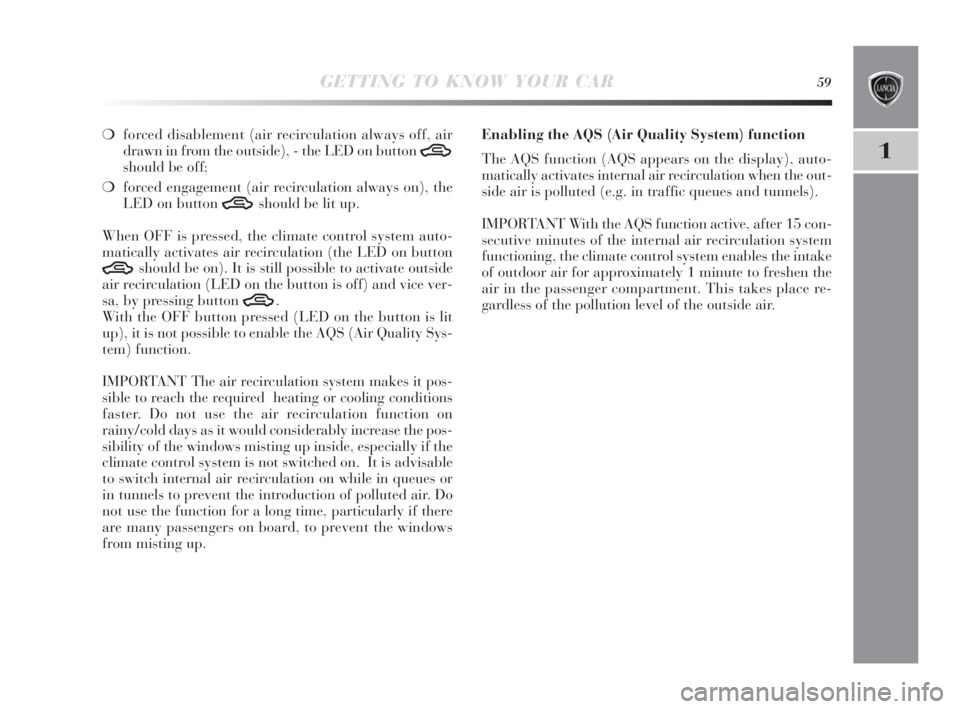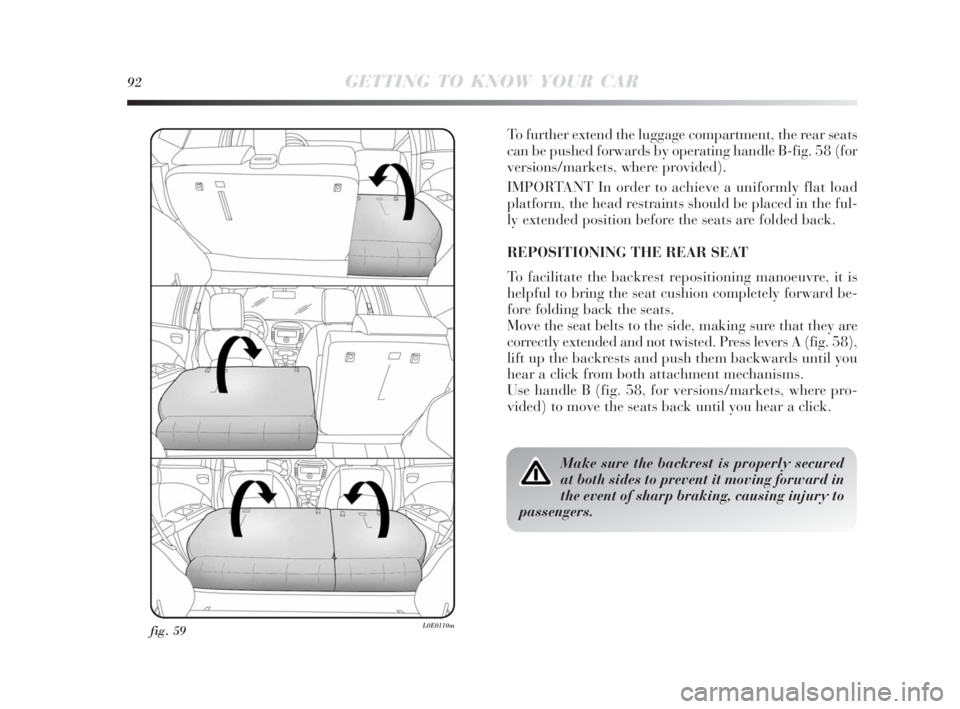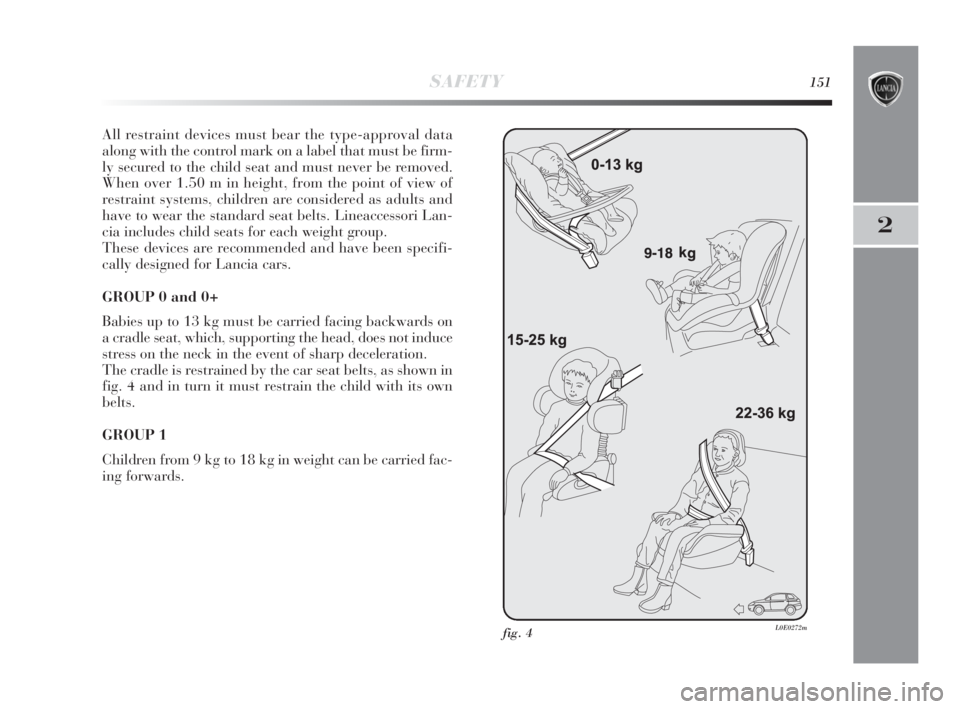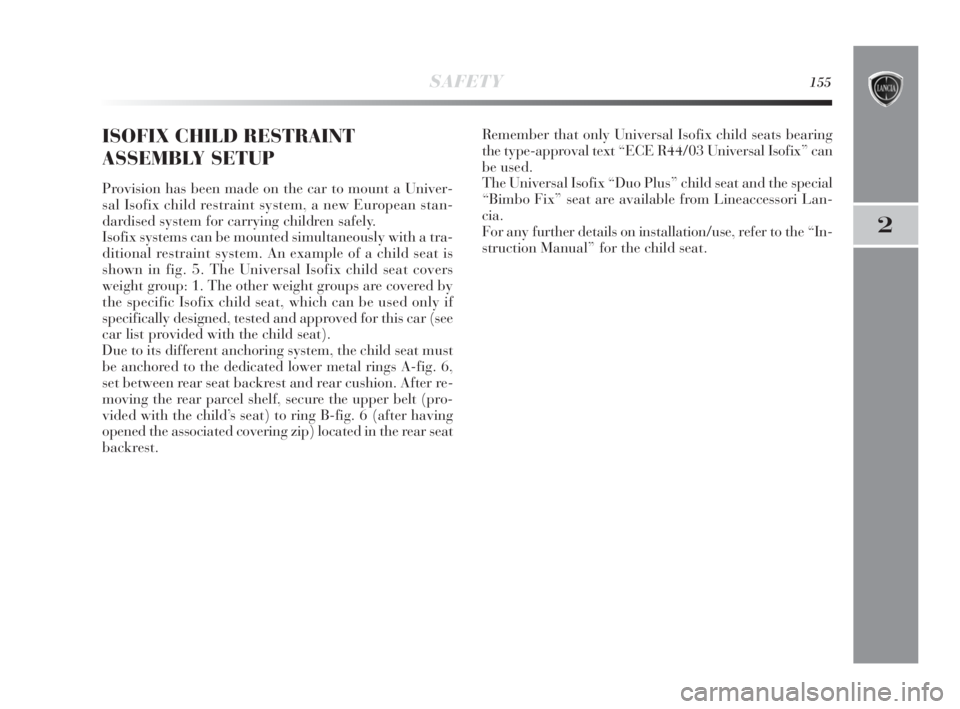ECU Lancia Delta 2010 Owner handbook (in English)
[x] Cancel search | Manufacturer: LANCIA, Model Year: 2010, Model line: Delta, Model: Lancia Delta 2010Pages: 276, PDF Size: 5.31 MB
Page 60 of 276

GETTING TO KNOW YOUR CAR59
1
❍forced disablement (air recirculation always off, air
drawn in from the outside), - the LED on button
Tshould be off;
❍forced engagement (air recirculation always on), the
LED on button
Tshould be lit up.
When OFF is pressed, the climate control system auto-
matically activates air recirculation (the LED on button
Tshould be on). It is still possible to activate outside
air recirculation (LED on the button is off) and vice ver-
sa, by pressing button
T.
With the OFF button pressed (LED on the button is lit
up), it is not possible to enable the AQS (Air Quality Sys-
tem) function.
IMPORTANT The air recirculation system makes it pos-
sible to reach the required heating or cooling conditions
faster. Do not use the air recirculation function on
rainy/cold days as it would considerably increase the pos-
sibility of the windows misting up inside, especially if the
climate control system is not switched on. It is advisable
to switch internal air recirculation on while in queues or
in tunnels to prevent the introduction of polluted air. Do
not use the function for a long time, particularly if there
are many passengers on board, to prevent the windows
from misting up.Enabling the AQS (Air Quality System) function
The AQS function (AQS appears on the display), auto-
matically activates internal air recirculation when the out-
side air is polluted (e.g. in traffic queues and tunnels).
IMPORTANT With the AQS function active, after 15 con-
secutive minutes of the internal air recirculation system
functioning, the climate control system enables the intake
of outdoor air for approximately 1 minute to freshen the
air in the passenger compartment. This takes place re-
gardless of the pollution level of the outside air.
001-142 Delta 3ed gb 30-11-2009 11:22 Pagina 59
Page 88 of 276

GETTING TO KNOW YOUR CAR87
1
Anti-pinch safety device
The vehicle is equipped with an anti-pinch safety device
for the upwards motion of the windows.
This safety system is capable of recognizing the presence
of an obstacle whilst the window is closing; when this hap-
pens, the system stops the travel of the glass and, de-
pending on the position of the window, reverses its move-
ment.
This device is also useful when the windows are activat-
ed accidentally by children on board the vehicle.
The anti-pinch function is active both during manual and
automatic operation of the electric windows. Following
the intervention of the anti-pinch system, the window trav-
el is immediately interrupted and subsequently reversed
until the lower end of travel is reached. During this time
the window cannot be operated in any way.IMPORTANT If the anti-pinch protection intervenes 5
times consecutively within 1 minute or a system failure
is detected, the automatic window closing function is in-
hibited. The window can then only be operated in steps of
half a second and the button must be released following
each step.
One of the following manoeuvres must be carried out in
order to restore correct operation:
❍switch off and restart the engine;
❍fully lower the window concerned.
IMPORTANT With ignition key at STOP or removed, the
electric windows remain active for about 3 minutes and
are deactivated the moment a door is opened.
001-142 Delta 3ed gb 30-11-2009 11:22 Pagina 87
Page 91 of 276

90GETTING TO KNOW YOUR CAR
CLOSING THE TAILGATE fig. 56
To close, lower the tailgate and press down near the lock
until you hear it click. There are handles (B) provided
inside the tailgate to allow it to be closed more easily.
fig. 56L0E0047m
If you travel in areas with few filling stations
and you want to transport fuel in a spare
tank, respect the applicable laws, using on-
ly an approved, suitably secured tank. In the event
of a collision the fire risk is increased all the same.
Take care not to knock objects on the roof rack when
opening the tailgate.
Never exceed the maximum allowed load in
the luggage compartment; see chapter 6.
Make sure that the objects are arranged care-
fully in the luggage compartment so that they will
not be projected forwards following sudden brak-
ing. Do not travel with the tailgate open: exhaust
fumes could be introduced into the passenger com-
partment.
001-142 Delta 3ed gb 30-11-2009 11:22 Pagina 90
Page 93 of 276

92GETTING TO KNOW YOUR CAR
fig. 59L0E0110m
To further extend the luggage compartment, the rear seats
can be pushed forwards by operating handle B-fig. 58 (for
versions/markets, where provided).
IMPORTANT In order to achieve a uniformly flat load
platform, the head restraints should be placed in the ful-
ly extended position before the seats are folded back.
REPOSITIONING THE REAR SEAT
To facilitate the backrest repositioning manoeuvre, it is
helpful to bring the seat cushion completely forward be-
fore folding back the seats.
Move the seat belts to the side, making sure that they are
correctly extended and not twisted. Press levers A (fig. 58),
lift up the backrests and push them backwards until you
hear a click from both attachment mechanisms.
Use handle B (fig. 58, for versions/markets, where pro-
vided) to move the seats back until you hear a click.
Make sure the backrest is properly secured
at both sides to prevent it moving forward in
the event of sharp braking, causing injury to
passengers.
001-142 Delta 3ed gb 30-11-2009 11:22 Pagina 92
Page 108 of 276

GETTING TO KNOW YOUR CAR107
1
SWITCHING OFF THE SYSTEM
Manual method
The system can be deactivated by pressing button A-fig. 71
on the dashboard.
Confirmation of system deactivation is signalled by the
LED on the button going out and a message 1-fig. 72 ap-
pearing on the display.
Automatic method
The system can be deactivated automatically (if the sys-
tem is required it will therefore need to be reactivated).
The driver is advised that the system has been turned off au-
tomatically by three consecutive acoustic signals and the mes-
sage 1 – fig. 72 in the instrument panel display after the fol-
lowing situations:
❍the driver does not keep his hands on the steering wheel
(indication 2-fig. 72 is shown on the instrument pan-
el and a buzzer sounds until the driver places his hands
back on the wheel. This is considered a dangerous con-
dition and the system is automatically deactivated);
❍triggering of the vehicle safety systems (ABS, ESP,
ASR, DST and TTC);
❍the driver sets the sports driving pressing the SPORT
button (for versions/markets, where provided).
WARNING: the system cannot be activated if the driver
has previously selected the sport driving mode. The im-
possibility of using the system will be communicated to
the driver by three consecutive beeps and by the displayed
message 1 in fig. 72.SYSTEM FAILURE
In the event of a malfunction, the system reports the fault
via a message 3-fig. 72 appearing on the display and a
buzzer sounding.
IMPORTANT
The driving advisor is unable to operate following a malfunc-
tion in any of the following safety systems: ABS, ESP, ASR,
DST and TTC.
In the presence of indistinct, overlapping or
missing lane markings, the lane assistance
function is unable to aid the driver and the
system will be deactivated.
The driving advisor is not an automatic dri-
ving system and cannot replace the driver in
controlling the vehicle trajectory. The driver
is personally responsible for maintaining a suitable
level of concentration as traffic and road conditions
require, and for safely controlling the vehicle’s tra-
jectory.
The operation of the lane assistance function may be com-
promised by adverse visibility conditions (rain, fog, snow),
extreme lighting conditions (solar glare, darkness) or dirt
or damage, even partial, to the windscreen in the area
around the video camera.
The area of the windscreen by the TV camera should not
be partly or totally obscured by objects (e.g. stickers, pro-
tective film, etc.)
001-142 Delta 3ed gb 30-11-2009 13:22 Pagina 107
Page 152 of 276

SAFETY151
2
All restraint devices must bear the type-approval data
along with the control mark on a label that must be firm-
ly secured to the child seat and must never be removed.
When over 1.50 m in height, from the point of view of
restraint systems, children are considered as adults and
have to wear the standard seat belts. Lineaccessori Lan-
cia includes child seats for each weight group.
These devices are recommended and have been specifi-
cally designed for Lancia cars.
GROUP 0 and 0+
Babies up to 13 kg must be carried facing backwards on
a cradle seat, which, supporting the head, does not induce
stress on the neck in the event of sharp deceleration.
The cradle is restrained by the car seat belts, as shown in
fig. 4 and in turn it must restrain the child with its own
belts.
GROUP 1
Children from 9 kg to 18 kg in weight can be carried fac-
ing forwards.
fig. 4L0E0272m
143-164 Delta 4ed gb 12-02-2010 10:20 Pagina 151
Page 156 of 276

SAFETY155
2
ISOFIX CHILD RESTRAINT
ASSEMBLY SETUP
Provision has been made on the car to mount a Univer-
sal Isofix child restraint system, a new European stan-
dardised system for carrying children safely.
Isofix systems can be mounted simultaneously with a tra-
ditional restraint system. An example of a child seat is
shown in fig. 5. The Universal Isofix child seat covers
weight group: 1. The other weight groups are covered by
the specific Isofix child seat, which can be used only if
specifically designed, tested and approved for this car (see
car list provided with the child seat).
Due to its different anchoring system, the child seat must
be anchored to the dedicated lower metal rings A-fig. 6,
set between rear seat backrest and rear cushion. After re-
moving the rear parcel shelf, secure the upper belt (pro-
vided with the child’s seat) to ring B-fig. 6 (after having
opened the associated covering zip) located in the rear seat
backrest. Remember that only Universal Isofix child seats bearing
the type-approval text “ECE R44/03 Universal Isofix” can
be used.
The Universal Isofix “Duo Plus” child seat and the special
“Bimbo Fix” seat are available from Lineaccessori Lan-
cia.
For any further details on installation/use, refer to the “In-
struction Manual” for the child seat.
143-164 Delta 4ed gb 12-02-2010 10:20 Pagina 155
Page 180 of 276

IN AN EMERGENCY179
4
The kit cannot be used to repair damage to
the tyre sidewall. Do not use the fast repair
kit if the tyre is damaged as the vehicle has
run a flat tyre.
If the wheel rim is damaged (the channel is
so deformed as to cause air leakage) it can-
not be repaired. Do not remove the foreign
body (screw or nail) from the tyre.
IMPORTANT INFORMATION:
The sealing fluid of the quick tyre repair kit is effective
with external temperatures between -20 °C and +50 °C.
The sealing fluid will expire.
Do not operate the compressor for longer than
20 minutes consecutively. Risk of overheat-
ing. The quick repair kit is not suitable for
definitive repairs. Tyres may only be repaired tem-
porarily.
175-214 Delta 4ed gb 24-02-2010 14:36 Pagina 179
Page 202 of 276

IN AN EMERGENCY201
4
fig. 27L0E0166m
fig. 26L0E0165m
REPLACING AN INTERIOR BULB
For the type of bulb and power rating, see “Bulb types”.FRONT COURTESY LIGHT
To replace the bulbs proceed as follows:
❍work in the points shown by the arrows and remove
light A-fig. 26;
❍open the protection lid B-fig. 27;
❍replace bulbs C releasing them from the side contacts;
make sure that new bulbs are correctly clamped be-
tween contacts;
❍close flap B-fig. 27 and secure courtesy light A-fig.
26 into its housing, making sure that it clicks into place.
IMPORTANT In some versions, the courtesy light in fig.
26 is at the back (electric sun roof version). To replace the
relevant bulbs, refer to the procedure described in para-
graph "Rear courtesy light" in this chapter.
175-214 Delta 4ed gb 24-02-2010 14:36 Pagina 201